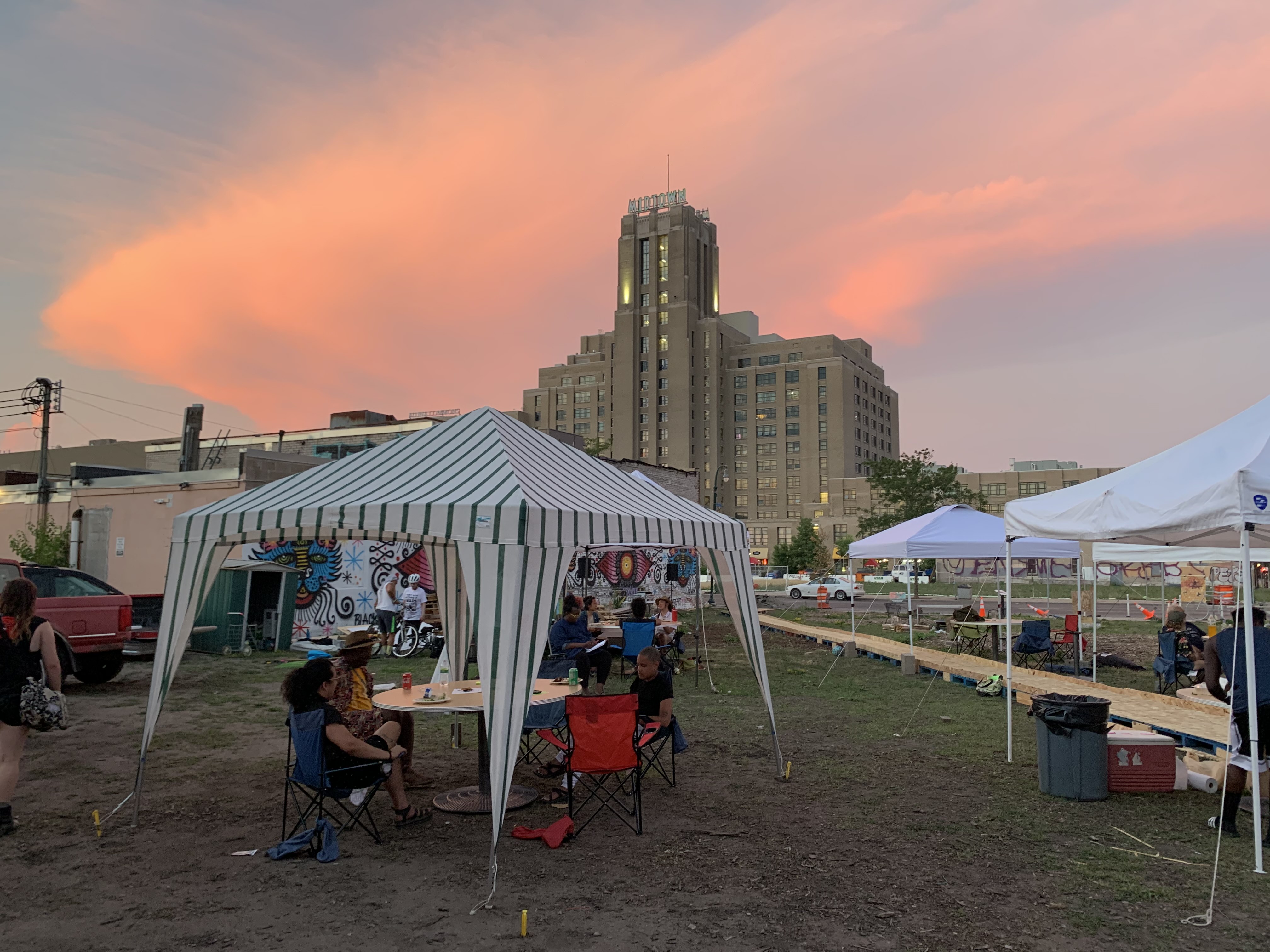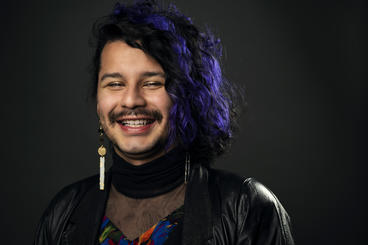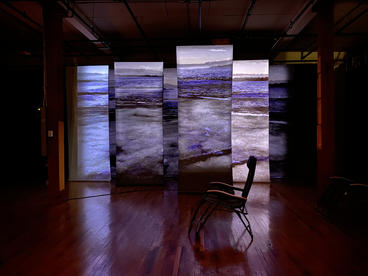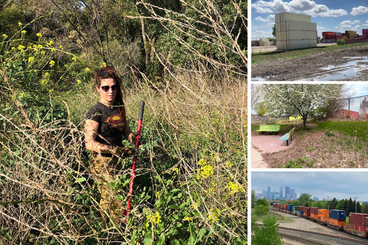
FEATURED ESSAY
Summer 2021 Residency: Lake Street Truth Collective
The summer artists-in-residence in the Weisman’s Target Studio for Creative Collaboration, the Lake Street Truth Collective, comprise a newly-formed group of artists and cultural organizers who love Lake Street and the people who call that neighborhood home. After a year of injustice, burning and protests, economic instability and pandemic, the Lake Street Truth Collective is coming together with community members in the neighborhood to foster opportunities to feel seen and heard after this traumatic year, to engage in difficult conversations about the truth of our circumstances, and to rebuild a sense of belonging and connectedness to this land and one another. Throughout July on the Roberts Shoe Store Lot at Chicago and Lake Street, the Collective is organizing eight community dinners as part of a grassroots “Truth and Repair” process. Facilitated dinners create structure for participants of different backgrounds to discuss themes such as homelessness, immigration, community violence, and environmental threats. Free food, child care, and interpretation into Spanish, Somali and ASL, allow people from different backgrounds to participate and communicate more freely. Multi-lingual flyers spread the word in the surrounding neighborhoods, and passers-by who walk through the Lot on their daily path are actively welcomed to join in.
Find the full calendar of events >>
Follow along @LakeStreetTruth on Instagram >>
Artists’ Statement
Our Collective, many of whom are Latinx, are taking extra care to include Latinx neighbors and business owners, many of whom have been left out of larger conversations because of language barriers and long-term community isolation. Similar efforts are underway to ensure inclusion of the East African community. The events of this past year have greatly impacted Lake Street’s immigrants, yet their participation in community conversations has, thus far, been limited. We are also discussing specific outreach strategies for sex workers, drug users, and unhoused people who are all part of the fabric of the community.
To make the Roberts Shoe Store lot accessible and inviting for all, we are bringing together community artists, builders, and makers to fill it with art and shade structures built for community conversations and congregation during events. We built a boardwalk for wheelchair accessibility, which will soon connect to other jut-outs for accessible dancing and congregating. We are building & programming an accessible stage for events of joy, which will be able to host full bands. A community bulletin board, walls for visual art, a traditional Somali healing hut, and an altar for folks to commune with their loved ones no longer in flesh and blood are also planned for the site. This altar will be populated by commissioned portraits of East African and Latinx ancestors of the people of E. Lake Street. At the end of the month the portraits will be brought to different businesses to host the paintings at 12 community altars, and will be active til our collaborators launch the first-ever Dia de los Muertos Parade and Celebration at the end of October.
It is significant that our process takes place on the Roberts Shoe Store lot, especially because of its recent history. When it burned down in 2018, the building was home to over 40 artists who lost not just thousands of dollars in art and equipment, but a financially viable home for their artistic practices. And the lot sits eight blocks north of George Floyd Square, which has held space for Minneapolis communities since the unjust death of George Floyd, and the subsequent events that led to Lake Street burning.
Now more than ever, it feels urgent to reweave the social fabric of the E. Lake Street community and build connections between people who share this particular piece of land— people who have long been divided. We know that one series of conversations is just a drop in the river of this journey; we’re here to take the next step forward together.
As our Collective learns and grows together with the communities that surround us, we have become more invested in continuing our work, possibly for years to come. Conversations sprouting from our planning process will continue to be organized over the coming months, if financial support for our work continues. We plan to document our process and share it as a model with other communities and neighborhoods to learn from our experiences & are considering how to make this cross-cultural community-building work sustainable. We are also participating in the Black Visions Collective’s efforts to organize citywide people’s assemblies, and will be sharing our model as part of that work.
Current list of Collaborators
21 Days of Peace, Alo Osberg, Andrew Yarish, Angel Aguilera, Atlas Defense, [a collaborative of harm reduction groups], Barebones Theater, Bici Xicas, Burn Something Collective, Cempazúchitl Collectiva, Cynthia J. Zapata, Dia de los Muertos Festival, Erika Hernandez, Gabby Coll, Graves Foundation, Harry Waters, Jr., Ifrah Mansour, Jacquie Zepeda/Fireweed Workshop, Jennings Mergenthal, Kay Adams, Kya Concepcion, Latino Business Association, Latino Economic Development Center, Line3 Water Protectors, Maria Gutierrez, Marlene Rojas Lara, Mony Vega, Pangea World Theater, Quito Ziegler, Sabrina Diehl, Sagrario Torres Flores, Sami Pfeffer, Sex Workers Organizing Project, Tammey Skinaway, Uproar Performing Arts, Weisman Art Museum, Wing Young Huie, Xochi de la Luna, Yasmeenah, Yhante Williams/Black Pride, and many more.
About Lake Street and Chicago
The site holds significance to many who call Lake Street home, some of whom have held it dear for hundreds of years.
This is, and has always been, Dakota land. The Dakota were forced to sell lands east of the Mississippi starting in 1837, and in 1851 were made to sell nearly all lands west of the Mississippi. Minneapolis was founded in 1850. In 1881, the Chicago, Milwaukee, St. Paul and Pacific Railroad built a track just north of Lake Street, helping create industrial jobs for immigrant workers and a flow of goods through the area.
In the 1940s, a practice known as “redlining” prevented people of color from getting government assistance to purchase houses. The effects continue today, white residents are more likely to own houses, redlined areas are still home to more residents of color. In the 1920s – 1950s, racial covenants legally prevented non-white people from buying property. The predominantly Black and Mexican working class neighborhood to the North of Lake was destroyed in 1963 for the construction of 35W. Once it finally opened, it acted as a social and economic barrier, fencing in Lake St. and preventing outside access.
The Latino population around Lake Street exploded in the 1990s. Immigrants from South and Central America were able to find housing that was made cheaper by decades of government disinterest and sought to create community. Mercado Central opened in 1997 after years of local organization and planning stemming out of desire for a public market. In 2006, after 20 years of closure, the Sears Building reopened as Midtown Exchange. In 2018, an unexpected fire brought down the long-standing Robert’s Shoe Store, prior to the Uprising, along with many artist studios.


